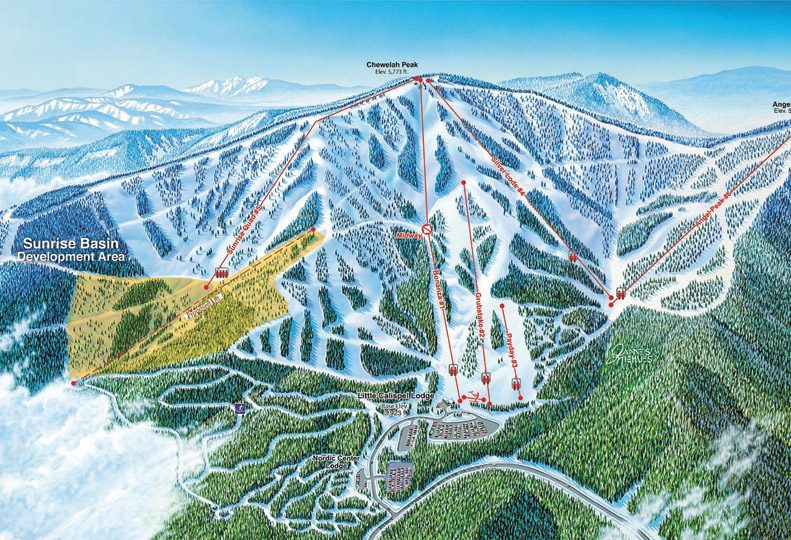
Home » 49 Degrees selling homesites
49 Degrees selling homesites
Sales kick off $500 million development at ski resort

August 27, 2015
Chewelah, Wash.-based 49 Degrees North Ski Area, located about 60 miles north of Spokane, is kicking off a $500 million Sunrise Basin resort community today by putting on the market a mix of 35 single-family and multiunit residential lots near the base of its Sunrise quad chairlift, says John Eminger, the resort’s president and owner.
Although the 320-acre Sunrise Basin development has been in the planning stage for nearly two decades, Eminger says the lots will be available for public purchase for the first time starting today with a launch party scheduled for 4-8 p.m. at Black Hawk Funding Inc.’s corporate office, at 1950 W. Bellerive Lane in Coeur d’Alene.
Lots also will be offered for sale at events scheduled at the Spokane Club downtown on Sept. 23 and Nov. 14, he says.
Eminger bought 49 Degrees North in 1996, and he says that since then, he’s been developing a master planned resort community there through a lengthy permitting and planning processes required by the U.S. Forest Service and the Washington state Growth Management Act.
“The master planned resort, gives (Stevens) county the authority to issue a development agreement,” he says. “Under the GMA, they want a plan that looks ahead at least 20 years.”
The Sunrise Basin development site is on the east slope of Chewelah Peak. The privately owned, 320-acre development site is surrounded by 2,100 acres of Forest Service land on which the resort is operating under a 40-year special-use permit.
“Sunrise Basin will be the first ski-in, ski-out community in Washington state,” Eminger claims.
The homesites available for sale today will be the initial phase of the 50-acre Alpine Glades subdivision, which will have up to 317 residential units, including detached single-family homes, duplexes, townhomes, and condominiums, Eminger says.
A lodge and hotel also are envisioned in Alpine Glades, he says.
Alpine Glades will be the first of three large subdivisions within the Sunrise Basin community, Eminger says.
As momentum picks up with the Alpine Glades development, the other subdivisions, tentatively named Sunrise Village and Royal Ridge, will be phased in, he says.
The subdivisions will be constructed in three- to five-year phases over 20 or more years, depending on market conditions, Eminger says.
The resort had announced similar development plans before the Great Recession, but held off on the sales launch until now.
The overall Sunrise Basin Development is envisioned to have up to 2,200 residential units, 800 hotel rooms, and up to 360,000 square feet of commercial space.
Hill Architects, of Portland, and Studio Cascade Inc., of Spokane, are designing the development, and Canada-based Stantec is providing engineering services through its Spokane and Salt Lake City offices.
Eminger says he anticipates initial prices will start at around $250,000 for a typical 8,000-square-foot lot, and construction likely will start on the first residential units in Aspen Glades in the spring of 2017.
Meantime, the resort is constructing a $1.8 million, 1.3-mile section of road that will link Alpine Glades to Flowery Trail Road inside the resort. That project includes extending power and telecommunications lines and roughing out interior roads within the subdivision.
Copenhaver Construction Inc., of Creston, Wash., is the contractor on the road project.
Blackhawk Funding, a private lender, is financing planning and infrastructure work for the development.
A limited number of resort visitors will be able to use the road next ski season to access two 24-foot yurts with a connecting deck that will be a precursor to a day lodge envisioned at the base of the Sunrise quad chairlift as part of the Alpine Glades development, Eminger says.
Eminger says he comes from a ranching family that relied on land-use permits on public land and now sees himself as a snow farmer, with a similar relationship with certain government and regulatory agencies.
“I still deal with the Forest Service every day,” he says. “Now we talk about skier visits instead of animal units.”
The resort’s skier visits track closer with forces of nature than the overall economy, he says.
During the recession, the resort benefitted from heavy snowfall. “It dumped and made my business go hog wild,” he says. It was different this year. “Now that the economy is supposed to be going good, ski areas got pounded into a recession.”
Latest News Real Estate & Construction
Related Articles




